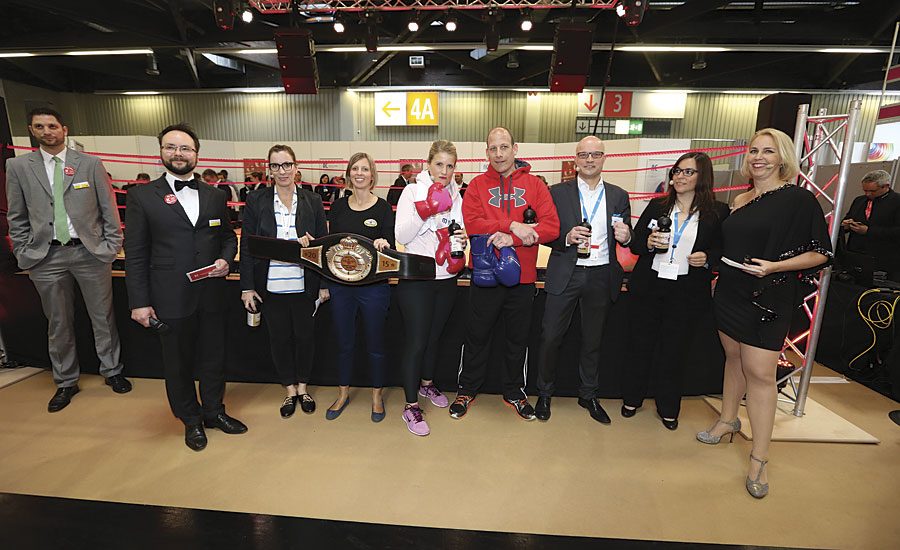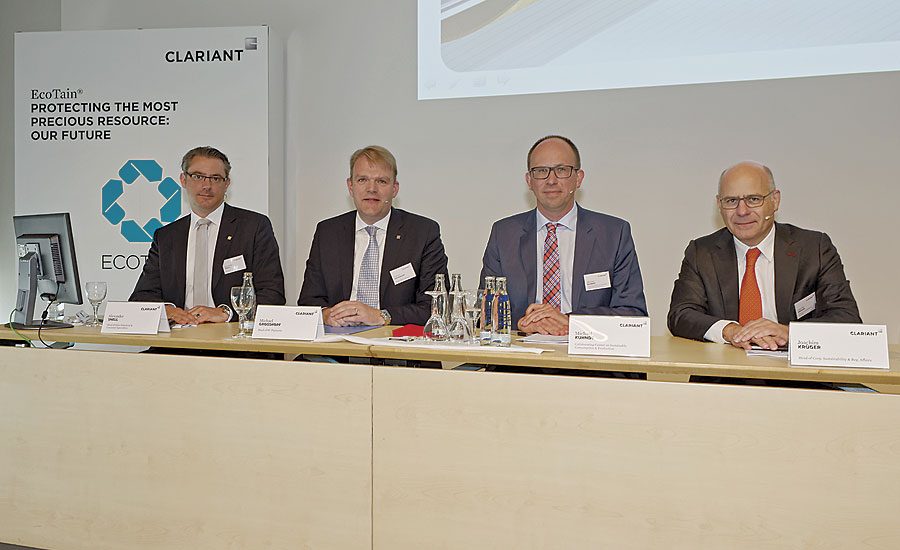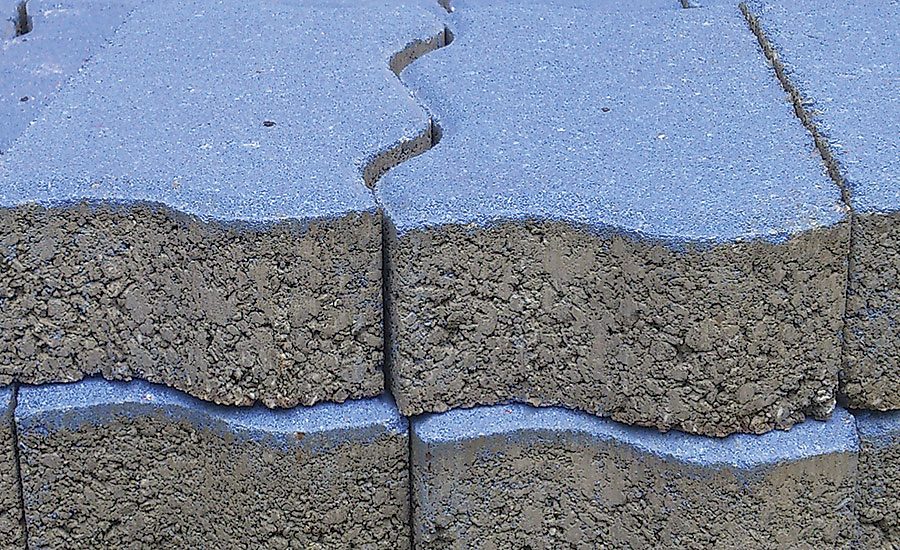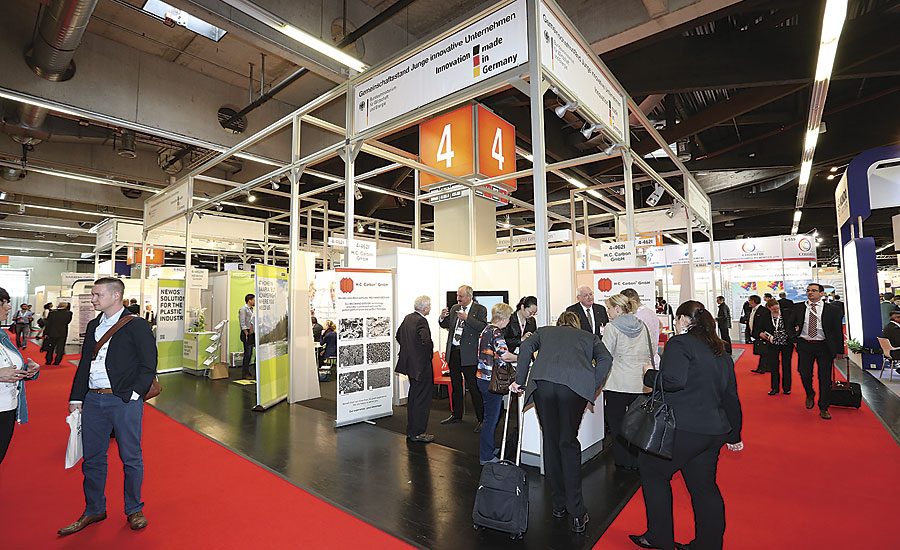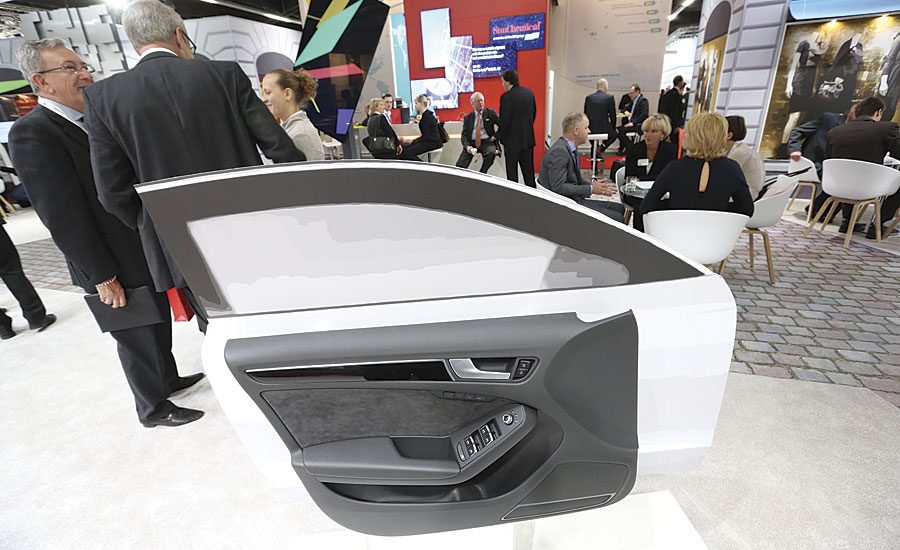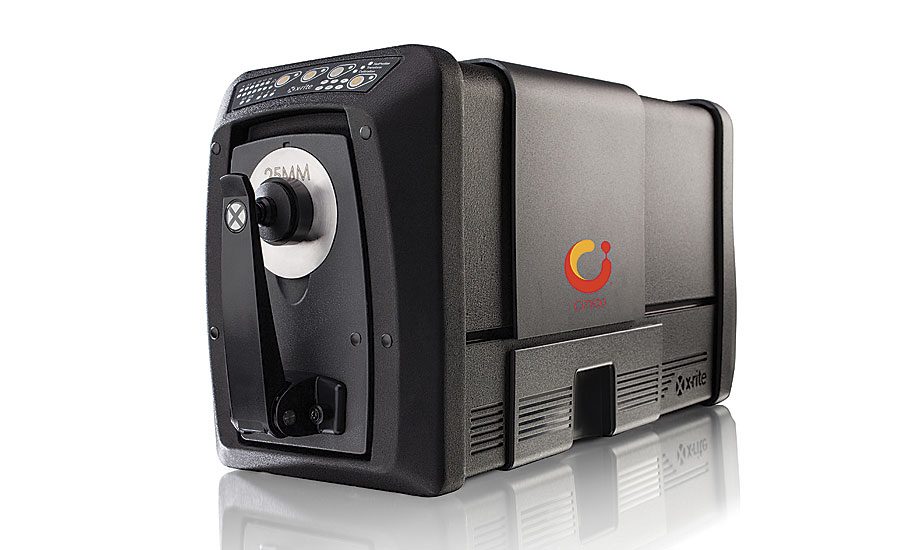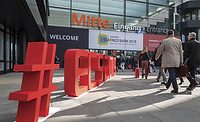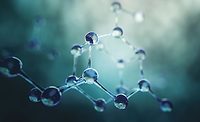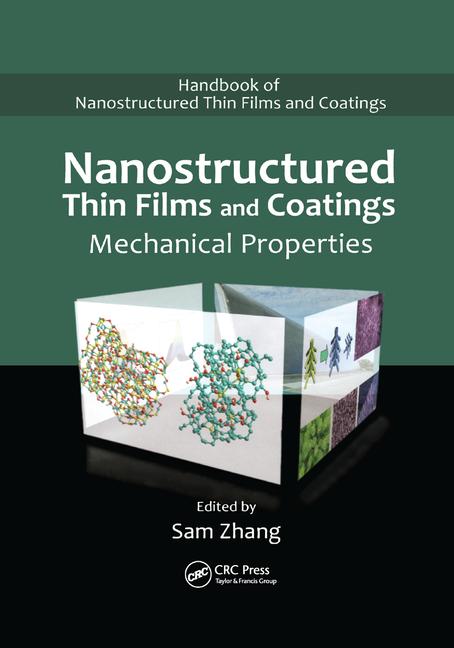With 1,024 exhibitors from 42 countries and 28,500 trade visitors representing nearly 110 nationalities, the European Coatings Show closed with new record highs – despite strike-related train cancellations throughout Germany. The world’s largest show for the coatings industry occupied seven halls in the Exhibition Centre Nuremberg and featured innovative products and technologies. With around 700 participants from 42 countries, the European Coatings Congress was well attended. 144 presentations given by prestigious speakers focused on the production of high-quality coatings, paints, sealants, construction chemicals and adhesives. The exhibits and presentations showed the diverse requirements met by modern coatings solutions, including products that are functional, safe, environmentally friendly and firmly committed to the idea of sustainability.
One highlight on the second day of the show was the premiere of the Innovation Slam. Set in a real boxing ring in front of an enthusiastic audience, five competitors set out to win over the spectators by pitching an innovative product in a presentation lasting 180 seconds. Voting by smartphone, the audience selected Dr. Berta Vega Sánchez from Bayer MaterialScience with her presentation, “First Biobased Polyurethane Crosslinker: Desmodur eco N,” as the winner.
I was able to sit down with many exhibitors at the show to discuss the products they were featuring. The following is just a sample of the technology that was on display.
Air Products
Air Products’ Additives team introduced its new developments at the ECS. Featured products included Dynol™ 960 and Dynol 980 superwetting surfactants, and Airase® 4500 defoamer for indirect food contact compliance.
Air Products’ Dynol 960 and 980 surfactants have been specifically designed to meet the growing need for high-performance waterborne coatings, inks and adhesives for low-energy surfaces. These new, low-foaming, optimized siloxane superwetting surfactants can provide premium equilibrium and dynamic surface tension reduction as well as improved flow and levelling for difficult-to-wet surfaces like wood, plastics, and dirty or nonferrous metal.
The company also highlighted its Airase 4500 defoamer for indirect food contact compliance. As a proprietary organic oil defoamer, the defoamer does not contain added mineral oils, HAPs, or alkyl phenol ethoxylates, making it suitable for a broad range of applications and useful for European food contact regulation compliance. In addition, Airase 4500 defoamer is designed to eliminate foam, pinholes and entrapped air in water-based inks, adhesives and coatings without generating surface defects.
Air Products’ Epoxy Additives team highlighted its latest innovations for flooring and protective coatings, including epoxy additives that can provide formulators with solutions for robust coatings with high aesthetics, low emissions and fast cure for minimal downtime. Featured products included Amicure® IC-221 and IC-321 curing agents for ultrafast, beautiful, low-emissions flooring, as well as the company’s latest innovations in its Total Reactive Technology™ curing agents.
Applied Graphene Materials
Applied Graphene Materials (AGM), a producer of specialty graphene materials, through a proprietary “bottom-up” synthesis process, reported positive preliminary findings following independent performance testing on graphene-reinforced polyurethane coatings, undertaken by PRA (formerly known as the Paint Research Association).
Although the extensive test program is continuing, the initial results demonstrate that low loading levels of AGM’s graphene nanoplatelets substantially enhance the scratch resistance and ultimate tensile strength of a polyurethane clearcoat, with minimal impact on transparency or color. This opens up the route to further development for commercial applications in numerous high-performance coatings.
AGM’s graphene manufacturing process is unique, sustainable, continuous and scalable, and the company is heavily focused on providing high-quality graphene, which is commercially viable and available in high volumes. The company is also focused on developing a range of consistent and stable dispersions, enabling successful application in volume manufacturing by its global industrial partners.
Richard Akam, AGM’s Market Sector Manager for Paints and Coatings, commented, “The results generated at PRA confirm our own research findings and indicate that these results can be translated to higher-volume applications. With a scalable manufacturing process and a strong supporting technical team within Applied Graphene Materials, we are well placed to help our customers apply and exploit graphene in their end products and markets.”
Peter Collins, PRA’s Technical Director, commented, “The preliminary results from our test work are very interesting and show that AGM’s well-dispersed graphene nanoplatelets offer the potential for significant property improvements in polyurethane coatings. We look forward to continuing to support AGM’s ongoing development work.”
Arkema
Arkema has a multi-technology and multi-product offering. With its extensive materials and technologies portfolio, Arkema covers the majority of coatings applications, including architectural and decorative paints, coatings for wood, plastics and metal, and inks. The Group offers a vast array of resins and additives with highly diverse chemistries and technologies.
Its portfolio of resins, solvents and additives includes:
- Acrylic emulsions for water-based paints (ENCOR®, Neocar®, Synaqua®, SNAP®);
- Polyester and alkyd resins for solvent-based paints (Chempol®, Crayamid®, Synocure®, Synolac®, Realkyd®);
- PVDF fluorinated polymers for long-lasting exterior coatings (Kynar 500®);
- Rheology additives (dispersants, thickeners) from Coatex for water-based coatings (Ecodis™, Coadis™,Coapur™, Rheotech™, Viscoatex™);
- Polyamide fine powder additives to improve texture and surface durability (Orgasol®, Rilsan® fine powders);
- Acrylates and methacrylate specialty resins for UV-curing from Sartomer;
- Oxygenated solvents (synthesis solvents, coupling agents and coalescence agents);
- Surfactants, polyols and molecular sieves (Dianol®, Adiansol®, Ensoline®, Surfaline®), and wetting agents and dispersants from CECA (Ensoline® et Surfaline®) yielding superior durability in industrial paints.
BASF
During a booth tour at the opening of the ECS, BASF gave a look at more sustainable solutions. BASF has recently reviewed its entire portfolio under sustainability aspects and has determined that the company offers more than 500 raw materials for the paints, coatings and construction industries in Europe that contribute significantly to the sustainable development along the value chain.
For the automotive market, the key topics for sustainability are durability, material efficiency and emissions reduction. BASF offers solutions like crosslinking agents, low-VOC binders or red-shifted UV absorbers that facilitate a highly efficient, primer-free coatings process technology. BASF’s portfolio can help to increase properties like gloss retention and scratch, chemical or weather resistance, which make coatings last longer. Moreover, highly saturated pigments offer a combination of very good hiding power, gloss and outstanding chroma. Hence, lower pigmentation level or thinner layers are needed to achieve increasingly sophisticated designs and better appearance.
For the furniture and flooring markets, key topics of interest are abrasion and chemical resistance, efficiency and emission reduction. In addition to pigments and pigment preparations for esthetically pleasing wooden surfaces, BASF provides a portfolio of resins and additives that enable highly resistant coatings. Moreover, the company supports customers in saving raw materials by providing resins and additives that achieve comparable properties as standard products at lower usage. To address the formulators’ needs to reduce emissions, BASF offers next-generation raw materials for UV and waterborne systems.
In the general industrial sector, BASF is focusing on low-VOC, efficiency and extended lifespan. Approximately 80 percent of industrial coatings are currently solvent-based systems. BASF expects the industry to keep moving towards more sustainable solutions. BASF’s portfolio of pigments, resins and additives is suitable for current and future formulations based on water- and high-solid systems. These solutions contribute to the reduction of VOCs. In addition, BASF’s raw material portfolio helps formulators to increase material and production efficiency. Examples are pigments, resins and additives that enable thinner coating layers, consume less energy or increase throughput.
In the construction and architectural coatings field, BASF is looking at efficiency, health, and production, application and energy costs. The company’s product portfolio covers dispersions, pigments, pigment preparations and additives for this market. These products make facades resistant against weathering, fading and dirt pick-up, improve indoor air quality and reduce the resources needed for the production of high- performance formulations. Advanced construction raw materials enable the cost- and resource-efficient, health-friendly production, application and use of building materials.
Bayer MaterialScience
Speaking at a press conference at the ECS, Daniel Meyer, Head of the Coatings, Adhesives, Specialties Business Unit at Bayer MaterialScience, underlined the company’s aim to “understand today what our customers will need from us tomorrow,” by identifying trends and unfulfilled requirements at all stages of the process chains. “By doing this,” Meyer continued, “we can invent exactly the products and technologies that help customers to position themselves and promote their profitable growth. This is at the very heart of our motto ‘Inventing for you’,” he added.
Meyer spoke of the company’s four new milestones: eco-efficient production processes, cost and energy efficiency, renewable resources and emission reduction, and high-performance materials.
“New milestones with polyurethanes that offer extra benefits right along the value-added chains” were a major focus of Bayer MaterialScience at the show. The company unveiled Desmodur® eco N 7300, its new hardener for polyurethane coatings and adhesives, emphasizing that about 70% of the product’s carbon content is biomass. Based on pentamethylene diisocyanate (PDI), this product is said to achieve the high level of conventional, petrochemical-based isocyanates and to complement polyols of renewable materials. It won the “Bio-based Material of the Year 2015” innovation award at the International Conference on Bio-Based Materials in Cologne as well as the ECS Innovation Slam Award, gaining the highest number of votes amongst visitors and exhibitors at the show. Commercial production is due to begin after REACH registration.
Another highlight was the new BLULOGIQ thermos-activated hardener technology for coating plastic parts on automobiles at low temperature, which, according to Bayer, combines perfect appearance with rapid drying of the coating. “BLULOGIQ switches on hardening just as film formation has finished,” explained Meyer. With a curing temperature of below 100 °C, BLULOGIQ can play a role in enabling plastics, composites and metals to be coated together, creating opportunities for future lightweight concepts in mass production.
Bayer also presented PASQUICK polyaspartic technology for use in corrosion protection and construction applications, which allows the number of coating steps to be reduced. The hardeners are suitable for flexible outdoor as well as indoor floor coatings, such as odorless comfort and sports flooring.
Meyer concluded his presentation with a glimpse of the future, saying that the company was aiming to work further on industrial-scale 2D and 3D printing based on polyurethanes.
Buhler
On exhibit at the Buhler booth were a variety of milling technologies, including:
-
Cenomic™ full-volume bead mill – The patented technical solutions of the full-volume bead mill offer unique possibilities. Depending on the requirements, it can be operated in single-pass or circulation mode. Lower working pressures, higher flow rates, improved quality and the resulting lower production costs have convinced a large number of users worldwide.
- MicroMedia™ X high-performance mill – This mill is distinguished by achieving exceptional quality levels and high grinding efficiency. Customers all over the world have reported lower production costs and increased profitability. It is designed for reliable use of micro-beads from 20 to 800 µm.
BYK Additives and Instruments
Under its motto, “Obviously Optimized,” BYK Additives & Instruments presented its product portfolio for the ongoing optimization of coatings, printing inks, adhesives and construction chemicals. The company concentrated on four central themes: enhancing product quality, achieving cost savings, conserving resources and sustainably optimizing processes.
At ECS, the company launched BYK-1640, a polymer-based, VOC- and silicone-free defoamer for aqueous systems that is also suitable for some applications that come into direct contact with food. Mineral-oil-based defoamers are widely used - mainly in applications in which price is a key criterion. Negative side effects such as separation tendency, odor, environmental aspects and the often lacking approvals for direct food contact mean that the market is looking for affordable alternatives. BYK-1640 is mineral-oil-free (and hence emission-free), neutral in odor, silicone-free and easy to incorporate. It provides high versatility that makes it widely applicable in architectural, protective, can and paper coatings as well as in adhesives, construction chemicals and printing inks.
BYK also presented new products for optimized results, such as the new high-molecular-weight wetting and dispersing additive DISPERBYK®-2055. This additive covers a broad application spectrum. It enables the production of high-quality pigment concentrates that can be used to cover almost the entire polarity range of let-down binders – from long-oil alkyds to aqueous binder systems. It is also well suited for co-grinds where pigment blends are used during the grinding process.
Celanese
Celanese presented new products to its Mowilith® line of waterborne dispersions, which includes vinyl acetate/ethylene (VAE), vinyl copolymer, pure acrylic and styrene acrylic. Mowilith dispersions make it easy for manufacturers to formulate products that satisfy the formulator and end customers’ desire for safer, cleaner and more sustainable paints and coatings.
New dispersions brought to the European Coatings Show included:
- Mowilith LDM 7510 – A pure acrylic dispersion with optimized balance of anti-blocking and elasticity properties for high-gloss paints and lacquers formulated without coalescent agents. The combination makes the product suitable for low-emission coatings products for decorative applications in the professional and DIY segment.
- Mowilith LDM 2301 – An APEO-free vina-vinylester-based copolymer especially designed for fire protection paints. The product provides an excellent cost-performance profile and can be used for water-based intumescent paint formulations.
- Mowilith LDM 1828 – A vinyl acetate/ethylene vinyl ester copolymer for interior paints. The dispersion shows good wet scrub resistance and excellent compatibility with silicate binders so that the dispersion is suitable for deep matte silicate interior paints.
Chromaflo Technologies
Visitors to Chromaflo Technologies’ booth were able to examine the colorants and software that underline the company’s integrated approach. The Chromaflo family of product brands includes more than 200 product lines and 7,000 products.
The Innovatint Tinting Management Centre is a new tool that can be used in conjunction with Chromaflo’s existing Innovatint software. “Through this tool, personalized tinting statistics can be accessed through an internet connection with a tablet, laptop or mobile phone,” said Alain De Haes, Product Manager of Innovatint. It’s also possible to control the tinting machine with a tablet, allowing formulations to be tinted remotely. Chromaflo can assist in cross referencing this data with other information, for instance, demographics. An additional module monitors the tinting machine and notifies the user if an error occurs whilst storing maintenance history.
Paint companies actively seek methods to decrease costs while making the right choice for the environment. Chromaflo Technologies has considered this with the introduction of pouch packaging for colorants. Compared to standard colorant packaging, the pouch results in less waste in terms of colorant residue and a lower volume of packaging waste. According to Jeroen Hofman, Director of Product Management and Marketing, the pouch is the future of colorant packaging, “The pouch has a lower CO2 footprint and increased user friendliness, which is why we see it as an innovative and sustainable choice.”
Colorants need to provide color reproducibility, smooth functionality and technical stability, while having no effect on the properties of the final coating. Chromaflo Technologies offers this through their extended Chroma-Chem® industrial portfolio. This includes solvent-free product lines for special applications that are compatible with a range of different resin types, including polyurethane, polyaspartic, epoxy and acrylic while having no impact on the paint performance.
Novapint™ D colorants are developed for water-based façade paints and plasters, while the universal Monicolor™ C range is developed for architectural applications including solvent-based paints. Both ranges offer an intelligent combination of conventional colorants that have excellent solar heat reflection properties, and an innovative black colorant to replace carbon black or iron oxide black. These unique ranges of colorants enable the formulation of dark colors that achieve less heat absorption compared to conventional colorants.
Chromaflo Technologies’ in-plant portfolio includes Hydrasperse™ EU for water-based applications and Solvasperse™ AK for solvent-based applications. Designed for in-plant production use, their high color strength and batch to batch consistency provides a good base for reproducible and economical colors. The colorant ranges are designed to ensure a good price/performance balance with a number of economical colorants for a lower overall tint cost.
Clariant
Clariant rolled-out its EcoTain® sustainability excellence label – one aspect of its on-going efforts to support customers with a more sustainable product portfolio. At a media conference, Clariant emphasized its commitment to working with third parties, including customers, suppliers, policy makers and other stakeholders, to continuously improve the sustainability of its portfolio and add value. Clariant received the support of the think-and-do tank Collaborating Centre on Sustainable Consumption and Production (CSCP), to create a well-defined set of 36 criteria against which all its products can be screened. The process takes into account social, performance and environmental factors. Clariant assigns its flagship EcoTain label to those products showing best-in-class sustainability and performance excellence, providing a clear indicator to customers of their added value.
Joachim Krüger, Senior Vice President Corporate Sustainability & Regulatory Affairs, commented that the screening process -known internally as the Portfolio Value Program – provides a very transparent assessment benchmark to support customers looking to improve their own sustainability. “Portfolio screening, using comprehensive and well-defined criteria, gives us a clear idea of the sustainability of all of our products, and enables us to steer future portfolio improvements and R&D efforts towards greater sustainability,” he said. “The EcoTain label goes the next step, visibly letting our customers know which products exceed market sustainability standards and are best-in-class. We believe we are unique within our industry in offering this level of credible support to our customers,” Krüger added.
Clariant was joined at the press conference by Michael Kuhndt, Managing Director of the CSCP, who highlighted the tools and processes behind the development of EcoTain and the importance of developing the screening system through continuous dialog with stakeholders.
“The Portfolio Value Program is a pioneering approach and the result of intensive development effort. Its unique future-oriented criteria measure not only the direct footprint of our products, but their potential contribution to the development of sustainable products. It is our belief that these aspects, developed in close consultation with business, politicians, civil society, and academia, provide the solid base behind the EcoTain label and advance the chemicals industry’s support for a more sustainable society,” said Kuhndt.
Senior representatives from Clariant presented innovative products, and application-focused solutions and support services evolving from its sustainability improvement approach. These included products already qualifying for the EcoTain label. Michael Grosskopf, Head of Business Unit Pigments, and Alexander Snell, Head of Sales Industial Applications Business Unit Industrial & Consumer Specialties, featured examples from the approximate 40 current EcoTain products for the Paints & Coatings sector.
Newest Ceridust® solution “Ceridust 8091” based on renewable raw materials for decorative coatings, offers strong matting effects with outstanding scratch resistance. This Ceridust development offers manufacturers a step-change in performance from a biobased wood coating additive.
Biobased quinacridone pigments for automotive, industrial and decorative coatings. Hostaperm® Pink E, one of Clariant’s most important polycyclic pigments based on renewable bio-succinic acid, represents Clariant’s switch to renewable raw material without changes in, the product quality and the guaranteed specification.
Halogen-free flame retardant Exolit® AP 422 for more environmentally compatible intumescent coatings used in construction applications. The EcoTain-labeled nonhazardous flame retardant offers constant high quality and hydrolytic stability. Its production is highly material efficient and minimizes waste in production.
Easily Dispersible (ED) Pigments significantly improve the eco-footprint in paint manufacture by removing the bead mill step. The shortened processing time leads to increased production capacity while simultaneously generating savings in electricity consumption and generating less waste water. So far the complete ED range has been granted the EcoTain label.
Hostavin® light stabilizer dispersions for easy-to-incorporate and solvent-free UV light protection. Hostavin 3070 Disp. and 3330 DISP XP UV stabilizers, for waterborne wood finishes, automotive coatings and outdoor decorative coatings, satisfy EcoTain’s demanding criteria due to their excellent sustainability profile. In addition, they have the ability to combine state-of-the-art performance results at competitive cost versus other market alternatives.
Clariant has developed a set of sustainable dispersing agents for hazard-label-free pigment preparations, which combine the benefit of being compliant with ecolabel (e.g. Blue Angel and EU EcoFlower) and outperform standard products on the market. The set includes EcoTain-labeled Dispersogen® AN 200, which has very low VOC level (<1%), and has a favorable eco-tox profile being hazard-label free and readily biodegradable. It is suitable to disperse high pigment loads of organic pigments resulting in a high tinting strength in waterborne emulsion paints.
Clariant offers APEO-free surfactants for emulsion polymerization providing benefits along the value chain, ranging from improvements in the polymerization process to achieve top-grade latex quality to performance advantages of the obtained binders in architectural paints. Emulsogen® LCN 217, 287 and 407 have been awarded as EcoTain products. Among other sustainability aspects, they offer an environmentally friendlier profile, easy handling properties and a low VOC content. This helps polymerization customers to meet end user requirements for safer, low-odor paints.
Dow Coating Materials
The sustainability trend could also be seen at Dow Coating Materials’ (DCM) booth, where the company unveiled its PARALOID™ Edge Isocyanate-Free Technology that extends pot life while maintaining quick cure. “Choosing between longer pot life and faster cure time is an ongoing challenge of 2K polyurethane coating formulations that results in a trade-off on one or both of these key properties,” said Chuck Martz, Global Business Director for Industrial Coatings, Dow Coating Materials. “With PARALOID Edge Technology, formulators and applicators don’t have to sacrifice cure speed to extend pot life, or vice versa.”
The fast curing capability of the new technology can allow for faster return to service, while longer pot life can provide once per shift make-up, which can result in less material waste. The new solventborne offering also features application flexibility and is isocyanate and formaldehyde free.
“Current isocyanate-free offerings exist, but they require thermal cure. PARALOID Edge Technology not only offers ambient curing, but also can provide convenience, cost efficiency and an improved environmental, health and safety profile,” said Martz. “It’s a true innovation and a first in solventborne two-component urethane technology.”
The combination of benefits offered by PARALOID Edge Technology make it a distinctive offering in an expanding variety of markets including auto refinishing, agriculture and construction equipment (ACE), maintenance and protective coatings for metal, and industrial wood.
Applied as a primer in auto refinishing, PARALOID Edge Technology can offer dry-to-sand time in as few as 40 minutes according to recent research conducted by DCM. The isocyanate- and formaldehyde-free aspect of this product can also provide an environmental, health and safety benefit for the body shop.
For ACE applications, the technology may be used in DTM formulations or over primer in pigmented topcoats. Because it only requires ambient curing, PARALOID Edge Technology can allow faster throughput for OEMs, and longer pot life can reduce material waste.
The technology can also be used as a clear or pigmented topcoat for steel structures, tanks, rail cars, off-shore oil and gas pipelines, and more. Its weatherability makes this urethane technology an ideal choice for maintenance and protective coatings. Compared to standard 2K polyurethane coatings, when used as clear or pigmented primers and topcoats for interior wood applications like cabinetry and furniture, benefits to the applicator can include shorter dry time, less material waste and faster property development.
“PARALOID™ Edge Technology marks another milestone in our innovation portfolio and demonstrates our commitment to research, development and advancement in the growing industrial coatings market,” said Martz. “The broad industrial product line from Dow Coating Materials also includes MAINCOTE™ Waterborne Resins, AVANSE™ Acrylic Resins, PRIMAL™ Acrylic Resins ACOUSTICRYL™ Liquid Applied Sound Damping (LASD) Resins, and PARALOID™ Polyol and Thermoplastic Resins.”
Dow Corning
Two industry experts from Dow Corning detailed the company’s latest advances targeting paint, coating and ink applications. “The paint and coatings industry faces pressing challenges prompted by new applications, increased processing requirements and growing demand for more sustainable solutions,” said Chris Wall, Global Market Manager for Dow Corning Paint & Ink Solutions. “As a materials innovator, Dow Corning works with customers to formulate new solutions that address these and other challenges.” At this year’s European Coatings Show and Congress, we are presenting two of our most recent innovations: waterborne antifoams for aqueous coatings, and silicone additives for soft-feel and anti-scratch coatings,” Wall added.
Bertrand Lenoble, application engineer at Dow Corning, spoke about new antifoams for waterborne coatings. He detailed the advantages of silicone antifoams, which are often more effective at lower dosages and more persistent in the foaming medium than their organic counterparts. He also outlined key factors when selecting silicon-based additives for formulators developing the next generation of aqueous coatings.
Edward Crowston, application engineering leader for EMEA at Dow Corning, discussed the use of silicone particles to differentiate the touch and feel of coatings. He discussed the company’s latest innovation, a new water-dispersible silicone powder, Dow Corning® 601T Additive and an ultraviolet-compatible silicone powder Dow Corning® 603T Additive that feature high matting, scratch resistance and “soft touch” properties – all qualities valued by the automotive, electronics and furniture industries.
Also featured was Dow Corning® 700P Additive, a new siloxane-based dispersant introduced this year that offers coating formulators a more efficient and cost-effective solution for improving solventborne titanium dioxide dispersion – particularly for white, gray and pastel formulations. This advanced material also supports high color stability vs. organic dispersants, even after long exposure to high temperatures.
Emerald
Emerald has focused on providing solutions to help customers meet the new, more-stringent indoor air quality standards under ISO 16000-6, and featured some products to meet the newest industry standard.
The Emerald Kalama group showcased several new K-FLEX® low-VOC coalescents, focused both on performance and meeting the new stringent VOC regulations, such as those under the indoor air quality standards. K-Flex 975P, K-Flex 850S and the newest product in the line, K-Flex 500P, achieved non-detectable levels of VOC emissions in an ISO-16000 chamber test. The company has announced that K-Flex 850S received a certificate from RAL GmbH indicating compliance with the requirements for the low-pollutant paints and varnishes under RAL UZ 12a. Emerald sees this is a potential area to expand the product offerings under the EU Ecolabel or Blue Angel certifications.
Emerald has also been focused on developing specialty modified epoxy materials that exhibit fast cure property development in coatings and adhesives applications.
Evonik
“One Partner. Many Experts” was the theme of the Evonik Industries’ stand at the ECS. The specialty chemicals company presented innovative products and a comprehensive overview of its competencies for the coatings and adhesives industries.
“The coatings and adhesives industries are two of our most important growth markets, and our customers here can profit from our expert knowledge, our technological competencies, and our reliability,” said Dr. Claus Rettig, Chairman of the Management Board of the Resource Efficiency Segment at Evonik Industries AG. “Because they address sustainability megatrends such as resource efficiency, the product innovations we’re presenting at the ECS will allow us to support our customers’ growth in markets with an attractive future.”
Evonik’s stand introduced visitors to the company’s acquired knowledge in four fields of expertise:
- Functional polymer design – When used in the interior coatings of cans, DYNAPOL®polyesters for food packaging offer outstanding protection and represent a suitable alternative to BPA-containing systems.
- Interface control - DEGADUR® resins for flooring systems are environmentally safe, cure quickly and do not generate unpleasant odors.
- Surface modification - VESTANAT® binders deliver improved resistance to abrasion in high-gloss coatings. These new silane-modified hybrid binders provide a great deal of lasting chemical resistance. Evonik also presented SILIKOTOP® silicone hybrids for ultra-high-solids topcoats with excellent stone chipping and impact resistance as well as outstanding appearance and chemical resistance.
- Adhesives and sealants - POLYVEST® sealing compound is used in insulated glass windows and in automotive adhesives. And the double and triple panes in windows do a better job of insulating homes.
Evonik has consistently invested in new facilities and in expanding its existing production capacity in order to support its customers’ growth. Recent expansions include:
- A new silica production plant in São Paulo, Brazil. Projected startup: 2016. Applications for these products include paints and coatings to control rheological properties, to prevent settling, and to improve rust protection.
- A new production facility at the Essen, Germany site for manufacturing polymer dispersing agents for use in aqueous paint and printing ink systems; the upgrade will triple capacity in response to increasing global demand. The plant was successfully brought into operation at the beginning of 2015.
- A new hydroxyl-terminated polybutadiene (HTPB) plant in Marl, Germany went on stream in late 2014. Uses for HTPB include insulated glass windows, where it acts as a sealing compound, and in automotive adhesives.
- The company’s fifth integrated production line for isophorone and isophorone diamine started up in Shanghai in 2014. Products of isophorone chemistry include important components used for manufacturing industrial floorings, artificial leather, paints and coatings. The investment is aimed at dynamic markets in Asia.
- In 2014, Evonik acquired the SILBOND Corp. of Weston, MI, a leading producer of silicic acid esters, which are primarily used in coatings.
Hexion Inc.
Hexion Inc. unveiled new low-gloss options for its Albecor low-thermal curing resin systems for powder coating. These resins require less energy, cure faster and provide a better wearing, easier-to-maintain, matte finish for outdoor coatings.
The new Albecor resins are designed to cure at temperatures as low as 160 °C, compared to conventional systems that cure at 180 °C, reducing energy consumption up to 12.5% while maintaining equal or better resistance to outdoor elements. They also exhibit gloss stability across a range of curing temperatures and coating thicknesses.
“The trend in both architectural and industrial powder coatings is toward low-temperature and low-gloss systems,” said Donato Di Lorenzo, Marketing and Business Development Manager, Powder Resins at Hexion. “Low-gloss surfaces hide wear and scratches better than their high-gloss counterparts, are easier to clean and give buildings and equipment a softer, warmer look. Meanwhile, the demand for lower-energy, more-sustainable coatings has never been stronger. Hexion’s new resin technology is a response to both of these growing market trends.”
Typical applications for these resins include coatings for agricultural and construction equipment, transportation/mass transit, heavy carpentry and aluminum frames. Powder coatings based on the new Albecor resins are especially suitable for heavy machinery and agricultural and construction equipment because these resins deliver technical and visual performance equal to other coating systems, even on very large, high thermal inertia parts. Applicators also appreciate the faster, easier production which low temperature curing enables.
The new technology is based on dry blending two polyester powder resins with different reactivity levels. When cured, this contrast in reactivity results in a low-gloss surface.
Hexion also unveiled a new epoxy resin dispersion that closes the cost versus performance gap between waterborne and solventborne technologies. EPI-REZ™ Resin 7520-WD-52 has been shown, in product testing, to deliver corrosion resistance and substrate adhesion comparable to solventborne epoxy coatings used in transportation and industrial applications.
“This next-generation product provides a new, value-engineered option for our industrial epoxy coatings customers who are looking for a more environmentally preferred, high-performance, waterborne resin platform,” said Callum Scott, EMEA Regional Segment Leader. “For current waterborne epoxy resin users, EPI-REZ Resin 7520-WD-52 reduces the need to blend epoxy dispersions to achieve the desired balance of price and performance.”
Additionally, EPI-REZ Resin 7520-WD-52 offers a shelf life of more than 12 months, which is longer than many competitive waterborne epoxy dispersions. Applications for the product include primers, mid-coats and direct-to-metal coatings for agricultural and construction equipment, for trucks and buses, or for shop-based industrial finishes.
A third new product introduced at the Hexion booth was Axilat™ HP 8530 redispersible polymer powder, specially designed to make tile adhesives more flexible, durable and workable. The unique formulation allows dry mix adhesive producers to meet the demands of today’s most challenging tiling applications, such as tile cladding on external insulation finishing systems, or heated flooring tiles.
Hoffman Mineral
Hoffmann Mineral is an innovative supplier of fillers. Its classic Neuburg Siliceous Earth is a mixture of lamellar kaolinite and corpuscular, cryptocrystalline and amorphous silica. As a result of natural aging, the silica portion exhibits a round grain shape and consists of aggregated crytocristalline primary particles of about 200 nm diameter, which are coated partially opal-like. Such a unique structure is responsible for a relatively high specific surface area and oil absorption, which result in rheological activity and a range of application properties.
This functional filler is sold under its trade name SILLITIN, AKTISIL and SILLIKOLLOID. Currently new calcined products named SILFIT and AKTIFIT have been developed. The filler shows exceptional performance in various coatings and adhesives applications and gives excellent results as TiO2 replacement.
Huntsman
Huntsman explored the Jekyll and Hyde nature of TiO2 pigments in the context of resin durability and the creation of a new category of TiO2 pigments. Dr. John Robb, New Business Technology Manager at Huntsman Pigments, gave a floor presentation entitled, “A new benchmark in minimizing TiO2 photocatalysis.”
Resins can react differently when exposed to UV radiation. Some are susceptible to attack and can benefit from protection by the presence of TiO2 grades designed with strong UV absorption, while other resin systems are known for their intrinsic durability, and the addition of TiO2 can impair this functionality.
This is because TiO2, when it absorbs UV, can display photocatalytic functionality. Within the TiO2 industry, there has been a strong focus on limiting this photocatalytic tendency. To date, dense silica coatings have provided the best protection. However, Huntsman has developed the ALTIRIS®range of pigments to provide solar reflectance, and in so doing has achieved the biggest advance in restraining photocatalysis since the introduction of dense silica coatings.
During his presentation, Dr. Robb explored the mechanisms of UV degradation with reference to the impact of TiO2. He explained the different physical outcomes of the two main mechanisms, the importance of weathering test selection, and why the use of next-generation technologies, in the form of ALTIRIS pigments, can be advantageous.
Huntsman also launched a new di-functional primary amine. The JEFFAMINE® D-205 amine is a low amine hydrogen equivalent weight polyetherdiamine with a slower curing speed than conventional polyetheramines.
Extending gel times to around four hours longer than a standard JEFFAMINE amine system, the new amine may be suitable for applications where a longer pot life is required and where low viscosity, a low exotherm and a relatively high glass transition temperature are sought.
LANXESS
Specialty chemicals company LANXESS showcased its broad product range for the coatings industry, including colorants, biocides, flame-retardant additives and benzyl products.
One show highlight was the presentation of the company’s bright red pigments with particularly high chromaticity that will be produced at the company’s brand new iron oxide plant in Ningbo, China, starting in early 2016. The booth featured a 1:250 scale model of the 60 square kilometer chemical park, as well as a live broadcast each morning from the construction site. Due to outstanding process optimization in terms of waste recycling and energy consumption, the plant will exceed all existing regulatory requirements.
“ECS is the world’s most important platform for informing our customers and sales agencies in the coatings industry of new product developments,” says Jörg Hellwig, Head of the IPG business unit. “We are proud that we can already showcase our new red shades in Nuremberg, shortly before they go into full production for the global market in Ningbo.”
The Ningbo facility will be using a substantially improved Penniman Red Process developed by LANXESS to produce a new BAYFERROX “New Red” pigment range, providing unique color properties to the market. A test reactor in Krefeld-Uerdingen, Germany, is already producing the new grades for testing purposes.
The Penniman process using nitric acid is widely used in China for the production of iron oxide red pigments. On account of its formation of gaseous nitrogen oxides (NOx), as well as soluble nitrate and ammonium compounds, the process is a major challenge from an ecological perspective. While developing an innovative and more sustainable Penniman red process, it was discovered that apart from the known nitrogen oxide emissions, significant quantities of nitrous oxide (N2O) are also generated. The impact of nitrous oxide as a critical greenhouse gas is 300 times greater than that of CO2. Thanks to comprehensive scrubbing of off-gas streams containing NOx and N2O as well as efficient biological treatment of wastewater contaminated with ammonium and nitrates, the updated Penniman red process developed by LANXESS sets new standards in the iron oxide industry. The Inorganic Pigments business unit at LANXESS will employ this exceptionally sustainable technology in its new iron oxide production facility in China.
The LANXESS Rhein Chemie Additives business unit presented not only high-performance pigments such as Bayfast, but also its extensive line of Levanyl and Levanox-brand pigment preparations. Based on organic and inorganic high-performance pigments, these products make it possible to combine brilliant and pure hues with excellent lightfastness and weather stability.
LANXESS also showcased its benzyl products at ECS. The main exhibit is benzyl alcohol for the production of premium colorant and coating formulations. “As a consequence of our continuous optimization of our logistics processes, we provide our customers with high supply reliability,” underscored Thomas Krüger, Global Product Marketing Manager for benzyl products in the Advanced Industrial Intermediates business unit.
The LANXESS Material Protection Products business unit (MPP) showcased a comprehensive range of biocidal active ingredients and biocide formulations for the coatings industry. The preservatives protect wood coatings, emulsion paints, coatings and plasters from microbial attack. LANXESS developed Preventol A31-D for use in exterior coatings, such as algicidal and fungicidal facade paints. The aqueous dispersion contains slow-release diuron and an innovative combination of fungicidal active ingredients, meaning it displays a broad spectrum of activity even in low concentrations. It also has a positive toxicity profile and contains no components with VOCs.
Lonza
Lonza launched a new addition to the Proxel™ range of preservatives in Europe. This innovative in-can preservative is designed to address the challenging new regulatory requirements in the industry.
Proxel LS preservative is a dual-active, broad-spectrum biocide for wet-state preservation of water-based paints, adhesives and construction chemicals. This formulation offers powerful broad-spectrum protection at target dose levels that will not trigger the EU H208 allergen phrase.
The preservative is free of formaldehyde, MIT and VOC and is pH- and temperature-stable. It benefits from the use of two complementary active ingredients, providing an enhanced antimicrobial efficacy and protection from bacteria, yeasts and molds in a wide range of industrial applications.
David Tierney, Global Business Director, said, “Regulatory requirements are a key driver for biocide selection. Proxel LS preservative has been developed to not only enable customers to comply with the EU H208 labeling requirements but also to provide robust, long-term preservation for the target industries.”
Nuplex
Nuplex unveiled Acure, its latest technological breakthrough for coatings. Until now, formulators and applicators have always had to carefully strike a balance between dry time and pot life in 2K coating systems. In Acure, Nuplex has a system that decouples this adverse relationship.
When used in OEM coating applications Acure has the potential to reduce both manufacturing times and energy costs. When used in field-applied coatings, Acure is expected to significantly reduce return-to-service times.
Nuplex’s CEO, Emery Severin, says Nuplex scientists started working on the technology in 2007 and have developed a system that has potential to be used in a wide range of industrial coatings markets.
“Acure is built on Michael Addition chemistry, which up until now has been too reactive to be manageable in a coating context. Developed to precisely control this reaction, the Acure system delivers very fast dry times, extremely long pot life and low temperature cure. We’ve introduced the Acure system to a number of customers and received very positive feedback. We anticipate the system will be a breakthrough for Nuplex and the manufacturers that use it,” said Severin.
Acure is being introduced immediately in Europe and America, then in Asia, Australia and New Zealand towards the end of 2015. In addition to working conditions and environmental benefits, Acure is currently being trialed in a number of market segments including agriculture and construction equipment and protective coating markets.
The technology was unveiled at the ECS and was awarded the “European Coatings Award” at the European Coatings Congress.
Perstorp
Perstorp unveiled a range of Capa™ lactide copolymer polyols. The three new diols and one triol provide polyurethane formulators with increased opportunities to create high-performance products with reduced carbon footprints.
Capa lactides are copolyesters of Perstorp’s Capa caprolactone and renewable lactide monomers. Depending on grade, they have up to 50% renewable content. “The new products are characterized by the same high level of quality and consistency that users of current Capa caprolactone polyols are already familiar with,” says Jesper Fahlén, Global Product Manager Caprolactones.
All four new grades are low-viscosity liquids with improved solubility, enabling formulators to reduce or even eliminate the use of solvents. With their medium molecular weight and low crystallinity, Capa lactides provide polyols with properties that make them particularly suitable for soft-feel coatings. Coatings are characterized by high resistance to UV radiation, a property critical for consumer electronics and applications such as automotive interiors.
The lactides are transparent, contributing to the optical qualities of coatings. Their low viscosity facilitates processing, while their high quality and consistency are hard to match by other renewable alternatives.
Other products making their European Coatings Show debut were the latest extension to Perstorp’s Oxymer™ range of polycarbonate diols for increased weatherability of polyurethane dispersions, as well as castable and thermoplastic elastomers. New Oxymer HD56 and Oxymer HD112 are based on 1,6-hexane diol. The Oxymer HD range helps formulators to create products that withstand the toughest weather conditions, especially high temperatures and direct sunlight. Oxymer HD also provides high resistance to solvent degradation and yields polymers with high hardness, superior chemical resistance, good flexibility and excellent strength.
Charmor™ PM40 Care was also introduced, which provides the next development step in safe carbon source products for intumescent systems. Charmor polyols are incorporated into coating systems that are applied at a thickness of several millimeters, which under normal circumstances look no different from any other type of coating. However, in a burning building, as the temperature rises to around 200 °C and beyond, Charmor reacts with other ingredients in the paint formulation to form an insulating carbon foam, or char, which expands to become several centimeters thick. This insulates the steel from the heat of the flames, and so prevents or significantly delays it from collapsing. As a result, building occupants have more time to evacuate the building.
Intumescent coatings containing Charmor provide an alternative to other fire protection systems for steel structures such as cementitious systems or gypsum board. The structures weigh much less and, by being able to use an aesthetic coating rather than a substantial and aesthetically unappealing cladding system, architects can design buildings that combine improved safety with visual appeal.
SANITIZED AG
A new development from this Swiss specialist in antimicrobial hygiene function and material protection prevents loss of performance in textile treatments even under aggressive insolation. The product, Sanitized®TH 12-13, which can be used on textiles and for polymer coatings, offers long-lasting, UV-resistant protection against mildew.
A large number of treatments are available to protect textiles in outdoor use against environmental influences such as sun, wind and rain. However, user experiences and market observations show that the protective functions do not last in the long term. Sunlight intensity massively impairs the functions applied, with possible consequences such as premature material fatigue and unsightly stains caused by mildew infestation.
Sanitized TH 12-13 counteracts destructive infestation by micro-organisms. It is highly temperature resistant, can be used in conventional application methods and is suitable for aqueous coating systems. Sanitized TH 12-13 can be used in standard polymer matrices.
Products whose primary function is sun protection, such as tarpaulins, tents, awnings, parasols and umbrellas, architectural textiles, as well as coated textiles, will benefit from a UV-resistant, anti-mildew treatment using Sanitized TH 12-13, a product that is still convincing even under high air humidity and persistent rain. The new product is subject to the company’s standard of using only registered (BPR registration) and safety-tested antimicrobial active ingredients. This product innovation has already won the ITMA future materials award.
Sartomer
Sartomer presented its latest developments and recommendations to optimize curing rates and performance of emerging UV-LED curable technology. The company also unveiled PRO21615, a new generation of specialty acrylate, to bring superior properties such as soft touch and feel, and CN2306 designed to bring outstanding adhesion and scratch resistance to specialty coatings.
Also highlighted were the new MCure® 206 and the unique MCure range, developed to deliver key properties to MMA and 2K epoxy-based flooring and waterproofing systems. The most recent product developments to adopt low emission solutions and advanced mechanical properties for construction, adhesives and sealants were also highlighted.
Sartomer also launched ALLYLPEG(M)A, new building block for unique acrylic polymer design, offering a great potential for core shell synthesis.
With five new products added to the Sarbio® product line, based on renewable raw materials, Sartomer continues to build on the groundwork established by the conventional specialty acrylate and methacrylate performances to open new possibilities to develop innovative formulations with improved carbon footprint.
Sun Chemical
Sun Chemical Performance Pigments and its parent company, DIC, came together as one company at the ECS to explain how their product families of pigments and resins can be used together to create coatings for a full range of applications in the automotive, architectural, plastic and industrial industries.
Sun Chemical showcased its portfolio of effect, high-performance and classical pigments and preparations, including its Benda-Lutz® SPLENDAL for plastic automotive interiors, Benda-Lutz MAXAL EC for extra-durable architectural coatings, and Sunsperse® ECO dispersions for industrial finishes.
DIC demonstrated how combining Sun Chemical’s pigment capabilities with its high-functionality resins and additives, including BURNOCK® acrylics polyurethane resins, CERANATE® polysiloxane-acrylic hybrids, and MEGAFACE additives, can provide key ingredients needed for superior coatings products.
Sun Chemical introduced new fine-particle-sized aluminum flakes to its Benda-Lutz MAXAL EC line-up. The two new products offer a superior level of brightness that is unusual for their small size, while providing the same stain resistance offered by the line’s EC encapsulation technology.
Benda-Lutz MAXAL EC encapsulated pastes add enhanced gassing stability in waterborne paint and provide resistance to alkali and acid staining without impacting the optical properties of the base aluminum flake for a wide variety of applications including the coating of automotive parts and accessories and outdoor architectural coatings in powder and liquid paints.
When MAXAL EC is used together with DIC’s CERANATE polysiloxane-acrylic hybrid resins, coatings formulators produce an exceptionally durable, stain-resistant and self-cleaning coating. CERANTE waterborne resins can be ambient cured with the DIC WATERSOL curing agent to produce clear or pigmented finishes with the same weather stability of fluoropolymer chemistries. In addition, CERANTE coatings are self-cleaning and highly stain resistant, making them ideal for high-volume, low-maintenance applications ranging from outdoor living spaces to aluminum cladding and commercial buildings.
Sun Chemical has also expanded its zero-VOC and APEO-free Sunsperse ECO waterborne dispersion line with the addition of transparent red and yellow iron oxides. The dispersions stand out from the competition with their high color purity, clarity and reduced haze, making them suitable for a variety of industrial and architectural applications, including waterborne wood stains. As with all Sunsperse ECO products, the oxides possess a wide range of compatibility, stability and non-settling characteristics.
SunMica Exterior XC pigments were also on display at the booth. These pigments consist of thin, natural mineral mica flakes coated with optical layers of titanium dioxide and/or iron dioxide that have been specially treated to promote exceptional outdoor durability. Available in all major colors, including six particle-size distributions of pearlescent white, SunMica Exterior XC pigments add depth, shimmer and sparkle, providing unlimited styling possibilities.
Self-cleaning and fingerprint-resistant coatings can be formulated using DIC MEGAFACE additives. These unique additives can be formulated into a variety of coatings for a wide range of substrates and applications, including small countertop appliances, refrigerators and kitchen cabinets to impart self-cleaning and fingerprint resistance properties. Unlike conventional anti-graffiti additives, MEGAFACE is also compatible with any high-touch surface.
SYNTHRON
SYNTHRON is the European distributor of Chartwell. Their products offer some exciting alternative technologies to silane, which can present stability and hydrolysis problems. While being silane- and VOC-free, these new products promote adhesion and bonding.
Presented at the booth were the Moussex 7143 HE-V range of defoamers. These non-ionic vegetable oil emulsion-based defoamers for waterborne systems are suitable for styrene butadiene, styrene acrylic and acrylic-based lattices. They are FDA and EU/10/2011 approved for food contact applications, and are especially developed for the latex production process with good efficiency and stability.
Also on display was SYNTHRO® STAB TF 501 formaldehyde scavenger, which provides a depollution feature to construction materials. This 50%-active-matter waterborne liquid additive durably reduces the indoor air formaldehyde content by up to 80%. It is easy to handle as a low-viscosity colorless liquid and can be used for surface application on construction material (spray, dipping or brushing) or for mass addition during the production of the construction material.
Vencorex
Vencorex presented a wide range of isocyanates and solutions to develop more environmentally friendly technologies. These included:
- Tolonate™ aliphatic polyisocyanates crosslinkers for high-performance polyurethane coatings and adhesives, which offer exceptional durability and non-yellowing properties upon ageing, with high solids, low VOC options;
- Easaqua™ self-emulsifiable polyisocyanates used as crosslinkers of efficient environmentally friendly waterborne polyurethane alternatives to conventional solvent-based coatings;
- HDI and IPDI isocyanate monomers, essential building blocks for polyurethane dispersions (PUD);
- Scuranate™ TDI aromatic isocyanate for CASE applications.
Looking to the future, the company has a more-focused vision of its direction. According to Per-Erik Velin, Global Director Marketing and Sales, “We are clear that specialties will be our future. That is where the investments will go.”
The company is also looking at further expansions, including a new plant in Thailand that will open up a market area in Asia. The plant will have an annual capacity of 12,000 tons per year and will adopt Vencorex’s proprietary technology to produce high-quality trimers and biurets. Thailand is a strategic location and will provide Vencorex a competitive advantage to participate intensively in Asia’s polyurethane industries. The new plant will be ready to serve the Asian market in the second half of 2015.
“We want to strengthen our global position, and our enhanced presence in Asia will be a significant step forward. The new facility will allow us to stay near where the growth is and we wish to be a significant partner in developing the end-uses technology here in Asia”, said Sutin Chamulitrat, Vice President, Marketing and Sales.
WACKER
The Munich-based WACKER Group presented new binders and additives for the paint and surface-coating industries. The company premiered a silicone resin emulsion for wood protection coatings. The emulsion possesses hydrophobic properties that reliably protect wood outdoors against the damage caused by wetness. SILRES® WH is flexible enough to adhere strongly to wood surfaces, and imbues them with the water-repellent properties that are typical of silicones for many years. Weathering tests show that the product still protects impregnated wood against moisture and damp after 15 years. This means that silicone resins, which have proved successful at protecting mineral substrates over the decades, can now provide wood with lasting outdoor protection, too.
The 50-percent emulsion is based on a functional silicone resin and can serve as a water-repellent impregnating agent or as an additive for formulating film-forming wood stains. Due to its hydrophobic properties, SILRES WH reduces the water uptake of wood and so keeps its water content low. Weathering tests have shown that the silicone resin’s impregnating effect lasts for many years. Consequently, the wood is better protected against typical damage, such as fungus, mildew and insect attack, as well as cracks caused by swelling and shrinking. The use of biocides can be slashed as a result. SILRES WH added to paints and wood stains confers lasting water repellency, even in low concentrations.
The water repellency is clearly revealed by the beading effect which SILRES WH produces on wood surfaces. By providing wood with long-term protection, it greatly reduces the frequency of renovation and repainting compared with conventional wood preservatives. Best results are obtained by diluting it 1:4 to 1:9 with water. In waterborne stains, the product is admixed in amounts of up to three percent.
A further ECS highlight was the new PRIMIS® line, comprising binders and additives for advanced, high-value paints and architectural coatings. The new line combines organic and mineral components to deliver a binder with a completely novel property profile. The elastic, acrylic-ester-based, organic component performs a binder’s traditional role, offering strong adhesion and cohesion, good mechanical properties and enhanced processability. The solid mineral components, on the other hand, have outstanding protective properties and ensure long-lasting, bright colors and reduced dirt pick-up.
PRIMIS AF 1000 offers improved scratch and abrasion resistance, optimized thermal conductivity and water-vapor permeability, simple processing and even distribution. Additionally, the dispersion is characterized by excellent film formation, even at low outdoor temperatures, and by its elasticity while the polymer surface exhibits maxi-mum blocking resistance. What is more, it has low flammability due to its mineral content. The dispersion’s good pigment compatibility and color consistency keep exterior paints bright for longer – extending renovation cycles and, in turn, positively impacting overall costs.
The new PRIMIS AF 1000 dispersion is ideal for challenging exterior applications and expands WACKER’s extensive portfolio designed for plasters and exterior coatings.
Also new at the ECS was VINNAPAS® LL 3031, a waterborne polymer dispersion that is based on vinyl acetate, ethylene and vinyl chloride and has a very low environmental impact. The dispersion is produced without the use of alkylphenol ethoxylates, plasticizers, film-forming agents or solvents, is low-odor and boasts extremely low formaldehyde content (< 20 ppm). It also lends itself to paint formulations that have a low volatile-organic-compound content (VOC < 1 g/L).
VINNAPAS LL 3031 is a general-purpose binder for paints and plasters used both indoors and outdoors. It provides high color consistency, good pigment compatibility, high saponification resistance and compatibility with silicates. It is very easy to process and offers enhanced rheology. The binder dries quickly, but still possesses high binding power and abrasion resistance. As the dispersion yields flame-retardant polymer films, it is ideal for plasters and embedding coats for external thermal insulation composite systems. Moreover, VINNAPAS LL 3031 combines perfectly with silicone resin products from the SILRES BS range to yield water-repellent facade systems.
X-Rite
X-Rite Inc. hosted a press conference at its booth, where it highlighted new Ci7600/7800 spectrophotometers. Increasingly, paint is manufactured and mixed for distribution on a global basis. This global distribution also comes at a time when the demand for custom color is also increasing. To ensure the quality of these colors throughout the supply chain, paint manufactures have relied on benchtop spectrophotometers. But older spectrophotometers can be difficult to configure, and many have become contaminated with dust or paint. The operator is often unaware of these issues, resulting inconsistencies along the supply chain.
To solve this challenge, X-Rite has introduced the new spectrophotometer series. When used in conjunction with other X-Rite solutions, the Ci7x00 gives paint manufacturers an automated, software-driven set-up that assures consistent configuration across all locations in the global supply chain. The Ci7600/7800 spectrophotometers not only measure color quality, they also measure important details on the condition of the devices and the environment at the time of measurement. This critical information is provided in an audit trail that gives paint manufacturers a level of quality assurance that was not previously available to them.
Francesco Tomasello, Vice President of European Sales for X-Rite Pantone, said, “The industry continues to grow and adapt to the challenges of a global market place. Our new Ci7600/7800 spectrophotometers are an example of how X-Rite Pantone’s solutions keep pace with this trend. They provide users with an updated solution that not only ensures the accuracy of the color, but also ensure the accuracy of the instruments that are measuring the color.”
X-Rite also showcased its range of color measurement instruments that let paint manufacturers meet their specifications and tolerances. These include:
- The MA9X Multi-Angle Instrument family of hand-held spectrophotometers. These instruments give users the ability to easily, accurately and consistently measure traditional and special-effect coatings, including the multi-angle spectrophotometer MA98 that measures coatings with special effects. This is the only device that meets the ASTM Standard E2539 for the measurement of interference pigments.
- The Color Viewing Booth QC Spectra Light, which offers more standardized light sources than any other visual quality control solution. Also featured was the compact light cabin Judge II. This compact visual color evaluation system provides the closest fluorescent daylight simulation available.
- NetProfiler 3 software verifies, optimizes and certifies handheld and benchtop spectrophotometers used in the supply chain at locations around the world.
- The spectrocolorimeter RM200QC, which compares colors of laboratory samples or coated surfaces with reference standards. This instrument can also create reports that can be transmitted to the other partners in the supply chain.
- The noncontact benchtop VS450, which measures color and gloss measurements on dry and wet samples.
- Color iMatch, the intelligent software used for the formulation of paints. Color iMatch enables quick, accurate color analysis to optimize each recipe for cost and color accuracy.
Much more technology was presented during the three-day event. The next European Coatings Show will take place in the Exhibition Centre Nuremberg April 4-6, 2017.


